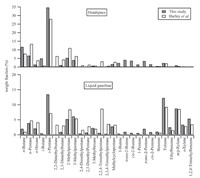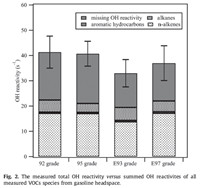Volatile organic compounds (VOCs) play an important role in ozone and secondary organic aerosol (SOA) formation [1]. Gasoline evaporation was estimated to contribute 5%-30% of anthropogenic VOCs emissions in mega cities in China [2, 3]. Since 2000,even though China has upgraded National Standards for gasoline of motor vehicles 5 times in according with vehicle emission standards (China I to China V). The standards related to important VOC changed slowly: the alkenes contents were required to drop from 35 vol% to 24 vol% [4],comparing to 18 vol% in Europe and 10 vol% in the US in 2000; the aromatic content has been around 40 vol% from 2000 till now.
The key to the investigation of the role of VOCs in air quality is its reactivity. VOC reactivity was defined as OH radical loss due to reaction with VOCs. Studies showed that the calculated VOC reactivity from speciation measurements were 20%-54% lower than the measured total reactivity in urban areas [5, 6, 7]. The difference between measured total reactivity and calculated reactivity from VOC specified concentrations was defined as missing reactivity. And the missing reactivity in ambient samples was attributed to either unknown/unmeasured primary or secondary VOC species. The missing VOC reactivity was also found in some source samples. VOC reactivity of anthropogenic emission sources was only measured for vehicular exhaust so far,and about 17% of missing reactivity was reported [8]. To check the VOC reactivity in primary emissions will be a useful approach to assess the current understanding of source profiles.
The aim of this work is to check whether there is a significant missing of OH reactivity in measured VOCs profiles from gasoline evaporation,and to explore the reason of the missing. Based on this consideration,the total OH reactivity and VOCs speciation from gasoline evaporation were measured.
2. ExperimentalWe collected 4 kinds of gasoline samples: Grades 92 and 95 gasoline samples in accordance with China V were collected from Beijing Sinopec Gas station in August 2014,while Grades 93 and 97 ethanol gasoline in accordance with China IV from Baoding city,Hebei Province in July 2014. Measurement system was shown in Fig. S1 in supporting information.

|
Download:
|
| Fig. 1. Comparison of VOC compositions of headspace and liquid gasoline measured from this study and Harley’s [12]. | |
Mixing ratios of 56 PAMS NMHCs species for gasoline evaporation and liquid gasoline were measured by automated online GC-MS/FID system [9]. The precisions of VOCs measurements ranged from 0.8% to 6.1% and detect limits varied from 1 pptv to 26 pptv for different species [10]. The total OH reactivity was measured by the Comparative Reactivity Method (CRM),an instrumental technique which compares the reaction of a single reagent with OH alone and then in the presence of all the reactive molecules from the gasoline evaporation samples. Pyrrole (C4H5N) was used as reagent,and was detected by a quadrupole PTRMS (Ionicon Analytics,Innsbruck,Austria) at m/z 68. Variation of pyrrole mixing ratio in working mode represents measured reactivity. The method was briefed elsewhere [11]. The detection limit was 10 s-1 and the total uncertainty of the measured reactivity was around 15%.
3. Results and discussionLiquid gasoline composition profile was presented in Fig. 1,to compare with the results from US gasoline samples [12]. It showed that C5-C6 alkanes and alkenes,as well as C7-C9 aromatics,were the main components of gasoline. And the major difference between China and US in gasoline composition was: gasoline used in China had higher alkenes content,6 wt% in China comparing to 0.1 wt% in US; higher aromatics,44-32 wt%.
The measured compositions of gasoline evaporation were also presented. As shown in Fig. 1,the C4-C5 light alkanes and alkenes were the dominant species in headspace vapor,while aromatics were largely lower in headspace,which were different from liquid gasoline compositions,probably due to the low vapor pressures of aromatics.
The VOC reactivity of gasoline evaporation was obtained by both direct CRM measurement and calculation based on VOC speciation measurement. The calculatedOH reactivity was the sum of reactivates of the measured 56 NMHCs species by the product of its mixing ratio and its rate coefficient with OH radical [13] (Fig. 2). It was shown that there was about 40% discrepancy between measured and calculated OH reactivity.

|
Download:
|
| Fig. 2. The measured total OH reactivity versus summed OH reactivites of all measured VOCs species from gasoline headspace. | |
We suspect that there were some species in gasoline headspace,low in mixing ratios but high in reactivity,which we did not quantify so far. As we could see that n-alkenes act as the biggest contributor to the calculated reactivity,only about 6 wt% n-alkenes in liquid gasoline can occupy 17 wt% in headspace,while contributed 70% of the calculated reactivity. Therefore we suspected that branched alkenes,which we did not quantified,could likely lead to the discrepancy shown in Fig. 2. Actually,the branched alkenes were measured to account for 6-10 wt% in VOCs emissions from gasoline evaporation [14, 15]. Applying this branched alkenes content to this work,we could estimate that the branched alkenes contribute 12%-25% of the total OH reactivity in our study. The role of branched alkenes in VOC reactivity could be significant and needs further investigation.
If the contribution of branched alkenes was added in,alkenes might accounted for 54%-67% of the total VOC reactivity of gasoline evaporation,and were the prior groups of VOCs needed to be controlled. From the source profiles within the last 15 years which were available [14, 15, 16] in Fig. 3,we found that the alkene content in gasoline has been reduced gradually,from 7.5 wt% to 6 wt% in liquid gasoline,from 20.0 wt% to 16.4 wt% in headspace. Even though the fuel quality standards in China had been upgraded 5 times due to the more stringent requirement of air quality,the alkenes contents in gasoline still kept at high level for long time,comparing to 10% in US.

|
Download:
|
| Fig. 3. Weight percentages of n-alkenes in headspace and liquid gasoline in different studies: (a) Lu et al. [16]; (b) Liu et al. [14]; (c) Zhang et al. [15]; and (d) this study. | |
We found that about 40% of total OH reactivity from gasoline evaporation was missing. The undetected branched alkenes could contribute largely to the missing reactivity. Alkenes were the major contributors to OH reactivity of VOCs from gasoline. Chinese gasoline has high alkenes content and changed very slowly in recent fuel quality improvement programs. We suggest that the reduction of alkenes is urgent for more efficient air pollution regulation.
AcknowledgmentThis work was funded by the National Natural Science Foundation (Nos. 41125018,41330635).
Appendix A. Supplementary dataSupplementary data associated with this article can be found,in the online version,at http://dx.doi.org/10.1016/j.cclet.2015.05.047.
| [1] | J. Williams, Organic trace gases in the atmosphere: an overview, Environ. Chem. 1 (2004) 125. |
| [2] | Z.B. Yuan, A.K.H. Lau, M. Shao, et al., Source analysis of volatile organic compounds by positive matrix factorization in urban and rural environments in Beijing, J. Geophys. Res. Atmos. 114 (2009) D00G15. |
| [3] | Y. Liu, M. Shao, S.H. Lu, et al., Source apportionment of ambient volatile organic compounds in the Pearl River Delta, China: part II, Atmos. Environ. 42 (2008) 6261–6274. |
| [4] | X. Yue, Y. Wu, J.M. Hao, et al., Fuel quality management versus vehicle emission control in China, status quo and future perspectives, Energy Policy 79 (2015) 87–98. |
| [5] | X.R. Ren, H. Harder, M. Martinez, et al., HOx concentrations and OH reactivity observations in New York City during PMTACS-NY2001, Atmos. Environ. 37 (2003) 3627–3637. |
| [6] | A. Yoshino, Y. Sadanaga, K. Watanabe, et al., Measurement of total OH reactivity by laser-induced pump and probe technique—comprehensive observations in the urban atmosphere of Tokyo, Atmos. Environ. 40 (2006) 7869–7881. |
| [7] | C. Dolgorouky, V. Gros, R. Sarda-Esteve, et al., Total OH reactivity measurements in Paris during the 2010 MEGAPOLI winter campaign, Atmos. Chem. Phys. 12 (2012) 9593–9612. |
| [8] | Y. Nakashima, N. Kamei, S. Kobayashi, Y. Kajiia, Total OH reactivity and VOC analyses for gasoline vehicular exhaust with a chassis dynamometer, Atmos. Environ. 44 (2010) 468–475. |
| [9] | X.L. Liu, L.M. Zeng, S.H. Lu, et al., Online monitoring system for volatile organic compounds in the atmosphere, Acta Sci. Circumstan. 29 (2009) 2471–2477. |
| [10] | M. Wang, L.M. Zeng, S.H. Lu, et al., Development and validation of a cryogen-free automatic gas chromatograph system (GC-MS/FID) for online measurements of volatile organic compounds, Anal. Methods 6 (2014) 9424–9434. |
| [11] | V. Sinha, J. Williams, J.N. Crowley, J. Lelieveld, The comparative reactivity method – a new tool to measure total OH reactivity in ambient air, Atmos. Chem. Phys. 8 (2008) 2213–2227. |
| [12] | R.A. Harley, S.C. Coulter-Burke, T.S. Yeung, Relating liquid fuel and headspace vapor composition for California reformulated gasoline samples containing ethanol, Environ. Sci. Technol. 34 (2000) 4088–4094. |
| [13] | R. Atkinson, D.L. Baulch, R.A. Cox, et al., Evaluated kinetic and photochemical data for atmospheric chemistry: volume II—gas phase reactions of organic species, Atmos. Chem. Phys. 6 (2006) 3625–4055. |
| [14] | Y. Liu, M. Shao, L.L. Fu, et al., Source profiles of volatile organic compounds (VOCs) measured in China: Part I, Atmos. Environ. 42 (2008) 6247–6260. |
| [15] | Y.L. Zhang, X.M. Wang, Z. Zhang, et al., Species profiles and normalized reactivity of volatile organic compounds from gasoline evaporation in China, Atmos. Environ. 79 (2013) 110–118. |
| [16] | S.H. Lu, Y.H. Bai, G.S. Zhang, J. Ma, Study on the characteristics of VOCs source profiles of vehicle exhaust and gasoline emission, Univ. Peking 39 (2003) 507–511. |
 2015, Vol.26
2015, Vol.26 


